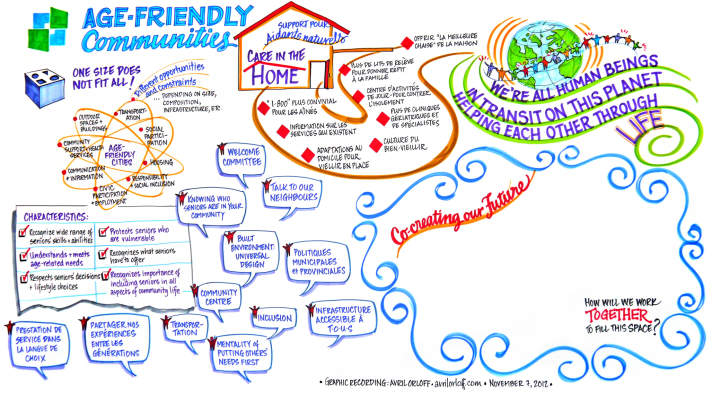
The New Brunswick Real Estate Association isn’t an organization that one would necessarily expect to join a province-wide effort to improve the culture of aging, but that’s what’s happened.
This is just one example of how creating a public dialogue on the future of aging and seniors’ care in New Brunswick is yielding surprising and positive outcomes.
Diverse New Brunswick organizations are showing a level of energy and commitment to a shared vision for an improved culture of aging. Some of these organizations typically compete for the same funding dollars.
New Brunswick has one of Canada’s most senior populations. That, combined with its tenuous economy, could make its future seem especially scary.
But, as a key champion of the effort, Jodi Hall points out, people are often more willing to join together and figure out a response when situations are looking difficult.
“I think everybody has a common interest to want to make a difference if they see a need, but sometimes it seems overwhelming and you don’t know where to start, so you don’t do anything,” says Jodi, director of operations for the New Brunswick Association of Nursing Homes (NBANH).
Opening a dialogue to the public — a summit in late 2012 was one core manifestation of this dialogue — has provided a clear path for people to start getting involved and take action on the issue of aging. The dialogue is focused on creating strategy for the future but there’s also a commitment to taking action on the ground immediately.
As groups engage, the intersection of their resources and interests has generated some interesting opportunities — such as the involvement of the real estate association.
“That’s a great example of how capacity was identified as a result of an unanticipated point of intersection,” Jodi says.
She’s excited to see additional capacity develop through this intersection of resources and interests as different groups come together, realize they have a shared interest and pool resources to make something happen.
Reflecting on conditions that have enabled this provincial effort to inspire the engagement is has to date, Jodi notes an intentionality in the process of bringing people together has no doubt helped foster the ongoing willingness to work together.
“I think sometimes when you’re trying to do something big, people wonder, ‘What’s in it for you, what are you trying to do, are you going to use me?’ ” Jodi says.
“So when we started this whole conversation, we thought if this is ever going to work, we just need to be very upfront with our issues, we need to be very honest about our thoughts on things and really be willing to listen to that of others — and also have a great deal of respect for the work that others do.”
There was also a strong focus on honouring each player’s voice, regardless of his/her prominence in the field or community.
“Having people feel empowered and that we have a mutual trust and respect for one another has been huge in getting all of us to lay down our individual agendas,” Jodi says.
“Although we’re also not ignoring those agendas, because the work that everyone is doing is needed, at the same time we’re embracing a bigger system picture, what can happen when we all come together.”
The fact the entire effort is anchored on a premise that New Brunswick’s aging population is not so much a problem to be solved as an opportunity to be embraced has also contributed to driving that collective energy.
A provincial collaborative to support healthy aging and care in the province has now been formed. The collaborative has been intentional about framing its priorities around three key themes that emerged in the 2012 public summit: caring communities; continuing care; and consultation and contribution.
While the work of ironing out the strategic side of this effort continues, the collaborative is also supporting the launch of some immediate activities “on the ground” through a process called social prototyping.
In contrast to running a pilot program, social prototyping involves working with a community to identify what it sees as a key priority item for action and then supporting the community to find assets, first within itself and then outside, if necessary, to get that work done. It’s a way to empower the community to take ownership of creating solutions, developing local leadership in the process. Efforts are ongoing on this front, with a first social prototype to launch in the village of Gagetown in two weeks.
Twenty-eight organizations have now formalized in writing their support for the provincial collaborative.
On June 24, they will convene again on a few key conversation points, including what strategies will be used to move the effort from what has been essentially a provincial discussion group to a formal entity.
The group will also continue work on connecting the dots with the community-based prototypes, which have a lot of excitement around them, Jodi says.
“I’m getting calls all the time. There are a lot of people who are eager to build these connections and lots of fantastic ideas that are emerging.”
The collaborative also wants to build the profile of this effort and subject and has identified a key opportunity linked to the province’s elections in September.
With support of the NBANH board, a leaders’ forum will take place two weeks before the election, with the five provincial party leaders answering five key questions related to aging and seniors’ care in the province.
Read more on this New Brunswick collaborative effort. Click here.
You can comment on this story below, or e-mail michelle(at)axiomnews.com.
A version of this article was originally written for the Charles Holmes Consulting news service. This repost, for which we received permission, follows the style guidelines of the original post. To learn more about generative newsroom options for your organization or community, please contact peter(at)axiomnews.com.





